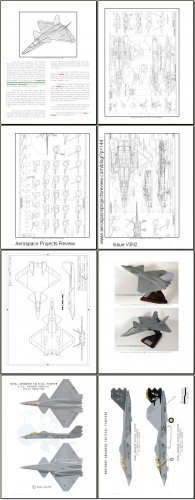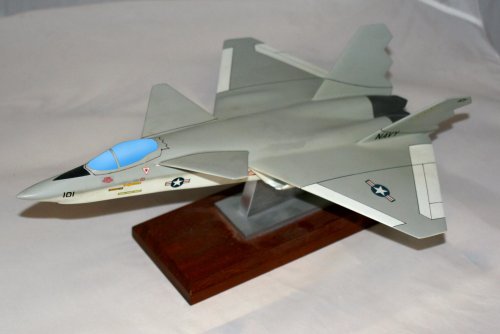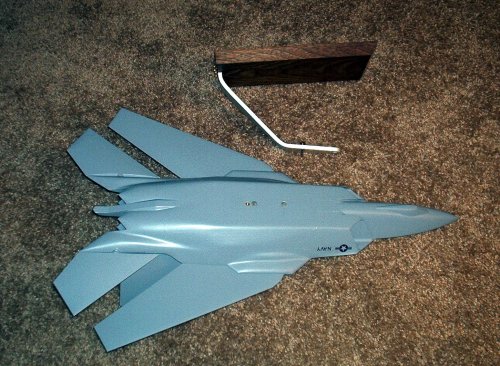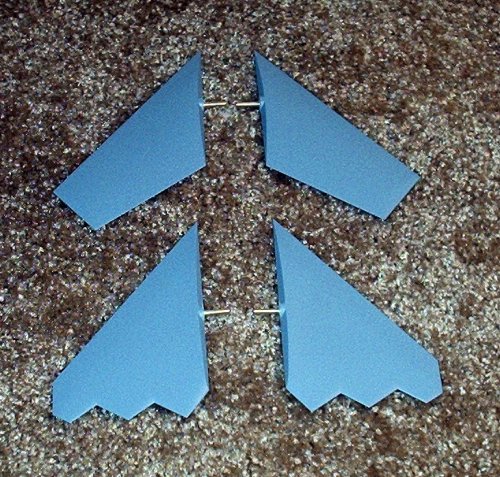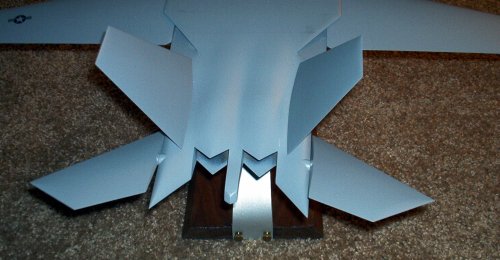Which was the superior NATF, design-wise? As in, which do you think would have been more ideal in it's role, the YF-23 version or F-22? I'm thinking the YF-23 variant would have been faster due to being lighter(no swing-wing mechanism). Not to mention the YF-23 was a fast aircraft to begin with.
You are using an out of date browser. It may not display this or other websites correctly.
You should upgrade or use an alternative browser.
You should upgrade or use an alternative browser.
NATF: planned Navy versions of the F-22 and F-23
- Thread starter Maki
- Start date
- Joined
- 3 October 2007
- Messages
- 1,960
- Reaction score
- 1,192
SDN said:Which was the superior NATF, design-wise? As in, which do you think would have been more ideal in it's role, the YF-23 version or F-22? I'm thinking the YF-23 variant would have been faster due to being lighter(no swing-wing mechanism). Not to mention the YF-23 was a fast aircraft to begin with.
That's an enormously broad question. The YF-22 vs -23 issue has been kicked around here for years. If you look around the forum you'll see. The NATF question makes it broader still. Vg vs fixed wings isn't as simple as you'd think. For example, the F-14 and F-111 (especially the latter) were much faster than the F-16 and F/A-18 despite being a lot heavier.
donnage99
ACCESS: Top Secret
- Joined
- 16 June 2008
- Messages
- 1,352
- Reaction score
- 850
And the word "superior" also include its maintainability. If it has to spend the majority of its time in the shop, instead being up there fulfilling mission, than it can't be considered superior even though its performance might be better. "Superior" implies which aircraft would fullfill a particular set of missions the best, in which case, readiness level is also a crucial part.
Question like this is impossible to answer. The ATF at least has prototypes flying and numbers throwing around, so we can have some info to base our hypotheses on. The NATF doesn't.
Another thing to note, unlike the ATF prototypes, which by their shapes, made it clear which aircraft is stealthier (though by how much is an open question) the canard on NATF-23 doesn't necessary mean it is less stealthy than NATF-22. One of the reasons canards are generally considered bad for stealth because the canards are not aligned on the same horizontal planes as the wings. However, inthe case of the non-canard NATF-22, it has variable sweep wings that are not aligned on the same horizontal plane as the horizontal tails. So from direct frontal view, both leading edges of the wings and tails are visible and exposed to radar.
Break-ups on the surfaces due to variable sweep wing also contribute to larger RCS, I suppose, unless, Lockheed has some radar blockers or some crap in those areas.
Question like this is impossible to answer. The ATF at least has prototypes flying and numbers throwing around, so we can have some info to base our hypotheses on. The NATF doesn't.
Another thing to note, unlike the ATF prototypes, which by their shapes, made it clear which aircraft is stealthier (though by how much is an open question) the canard on NATF-23 doesn't necessary mean it is less stealthy than NATF-22. One of the reasons canards are generally considered bad for stealth because the canards are not aligned on the same horizontal planes as the wings. However, inthe case of the non-canard NATF-22, it has variable sweep wings that are not aligned on the same horizontal plane as the horizontal tails. So from direct frontal view, both leading edges of the wings and tails are visible and exposed to radar.
Break-ups on the surfaces due to variable sweep wing also contribute to larger RCS, I suppose, unless, Lockheed has some radar blockers or some crap in those areas.
- Joined
- 17 October 2006
- Messages
- 2,393
- Reaction score
- 1,194
Abe G - IIRC the v-tails on the YF-23 were used entirely for pitch and roll. Yaw inputs came from differential movement of the wing TE surfaces.
- Joined
- 2 August 2006
- Messages
- 3,253
- Reaction score
- 1,520
LowObservable said:Abe G - IIRC the v-tails on the YF-23 were used entirely for pitch and roll. Yaw inputs came from differential movement of the wing TE surfaces.
I've yet to find any evidence of that and I don't know that differential TE control inputs on the wing would have enough control power to induce enough yaw at low airspeeds. I would love to know if it's true, though. I'll have to go to you tube and watch videos of it maneuvering to see if I can tell which flight control surfaces are moving.
However, regarding the NATF comparison, I do have an engineering study on advanced VG aircraft that show a modern version would pay much less of a weight penalty than the F-14 or F-111, due to advanced materials. But it's just a paper and we've heard claims like that before. Also, I'm not shocked the F-14 and F-111 were so fast, regardless of their weight, since they obviously had much higher critical mach numbers than the F-16 and F-18 and were optimized more for the high supersonic environment, as opposed to the transonic region like the LWF designs.
F-14D said:SDN said:Which was the superior NATF, design-wise? As in, which do you think would have been more ideal in it's role, the YF-23 version or F-22? I'm thinking the YF-23 variant would have been faster due to being lighter(no swing-wing mechanism). Not to mention the YF-23 was a fast aircraft to begin with.
That's an enormously broad question. The YF-22 vs -23 issue has been kicked around here for years. If you look around the forum you'll see. The NATF question makes it broader still. Vg vs fixed wings isn't as simple as you'd think. For example, the F-14 and F-111 (especially the latter) were much faster than the F-16 and F/A-18 despite being a lot heavier.
I was just wondering because the NATF YF-23 was so different from the regular YF-23, whereas the NATF YF-22 basically just looked like a Raptor with swing wings. After sifting through many posts about the YF-23(I lurked quite a while here before registering), the conclusion I drew was that the YF-23 was the stealthier, faster, and better ATF overall than the YF-22. However, being that the Naval versions were significantly different, I wondered if the results would differ(for example, NATF YF-22 being better than the NATF YF-23).
With the F-14 and F-111, the advantage that I can see off the bat over the F-16/18 are the swing wings and higher output engines. However the NATF YF-23 and YF-22 were to have the same engines right? NATF can sweep the wings back and the YF-23 NATF already had wings that were swept at a higher angle. Were there any wind tunnel tests done on models for the NATF's?
- Joined
- 3 October 2007
- Messages
- 1,960
- Reaction score
- 1,192
SDN said:F-14D said:SDN said:Which was the superior NATF, design-wise? As in, which do you think would have been more ideal in it's role, the YF-23 version or F-22? I'm thinking the YF-23 variant would have been faster due to being lighter(no swing-wing mechanism). Not to mention the YF-23 was a fast aircraft to begin with.
That's an enormously broad question. The YF-22 vs -23 issue has been kicked around here for years. If you look around the forum you'll see. The NATF question makes it broader still. Vg vs fixed wings isn't as simple as you'd think. For example, the F-14 and F-111 (especially the latter) were much faster than the F-16 and F/A-18 despite being a lot heavier.
I was just wondering because the NATF YF-23 was so different from the regular YF-23, whereas the NATF YF-22 basically just looked like a Raptor with swing wings. After sifting through many posts about the YF-23(I lurked quite a while here before registering), the conclusion I drew was that the YF-23 was the stealthier, faster, and better ATF overall than the YF-22. However, being that the Naval versions were significantly different, I wondered if the results would differ(for example, NATF YF-22 being better than the NATF YF-23).
With the F-14 and F-111, the advantage that I can see off the bat over the F-16/18 are the swing wings and higher output engines. However the NATF YF-23 and YF-22 were to have the same engines right? NATF can sweep the wings back and the YF-23 NATF already had wings that were swept at a higher angle. Were there any wind tunnel tests done on models for the NATF's?
Lockheed's NATF wasn't just a vg F-22. It was sufficiently different that it would have required its own, separate production line as opposed to a sub line offshooting (is that a word?) from the main one.
- Joined
- 17 October 2006
- Messages
- 2,393
- Reaction score
- 1,194
Sundog -
I'm sure that I heard that at the time or soon after the competition, and it made sense insofar as differential tail deflection would give you more roll than yaw.
I'm sure that I heard that at the time or soon after the competition, and it made sense insofar as differential tail deflection would give you more roll than yaw.
APR issue V3N2 has *finally* been released, with all kinds of NATF-23 goodies (among other designs: http://www.aerospaceprojectsreview.com/blog/?p=144). Included is color artwork provided by our very own Sundog.
Attachments
Evil Flower
ACCESS: Secret
- Joined
- 12 October 2006
- Messages
- 223
- Reaction score
- 63
Bought and downloaded. You do great work, sir.
donnage99
ACCESS: Top Secret
- Joined
- 16 June 2008
- Messages
- 1,352
- Reaction score
- 850
Is it possible to buy part of the issue? Or does it only come as a whole?Orionblamblam said:APR issue V3N2 has *finally* been released, with all kinds of NATF-23 goodies (among other designs: http://www.aerospaceprojectsreview.com/blog/?p=144). Included is color artwork provided by our very own Sundog.
- Joined
- 25 June 2009
- Messages
- 14,722
- Reaction score
- 6,054
donnage99 said:Is it possible to buy part of the issue? Or does it only come as a whole?Orionblamblam said:APR issue V3N2 has *finally* been released, with all kinds of NATF-23 goodies (among other designs: http://www.aerospaceprojectsreview.com/blog/?p=144). Included is color artwork provided by our very own Sundog.
I know you certainly didn't mean it that way, but I find the question somehow offensive.
Indeed, you wouldn't ask a book or magazine publisher if you can buy only, say, pages 45 to 53 or chapters 2 and 13, because you don't care about the rest of the publication!
- Joined
- 27 December 2005
- Messages
- 17,705
- Reaction score
- 26,115
Of course - its $20 for the YF-23 article alone. 
Come on, $10 US isn't much to pay for the YF-23 article alone, and you get a free bunch of other stuff with it you might find interesting.
Come on, $10 US isn't much to pay for the YF-23 article alone, and you get a free bunch of other stuff with it you might find interesting.
overscan said:Of course - its $20 for the YF-23 article alone.
And if you're only interested in the NATF-23... it can be yours for the low, low price of only $30.
If you only want the NATF-23 display model photos, those are only $40.
Ask me about my special per-pixel-pricing options.
donnage99
ACCESS: Top Secret
- Joined
- 16 June 2008
- Messages
- 1,352
- Reaction score
- 850
I only ask because I remember (correct me if I'm wrong) you had the option in your website to download printed version of whatever page you want for a certain amount of price. I've never really been interested in space projects. I don't mind paying for the whole issue. I dont have a problem paying the whole issue since this is pretty much gold mine that only comes once in a decade but only ask since I thought you have such option on your site.
donnage99 said:I only ask because I remember (correct me if I'm wrong) you had the option in your website to download printed version of whatever page you want for a certain amount of price.
I don't think I ever had that (I think I once floated the idea, but never did it). I do offer some individual articles: http://www.aerospaceprojectsreview.com/articles.htm
The bulk of those are un-altered articles from the original print run of APR. Two of them - D188A and B-58 SSTs - are specially prepped versions of the updated versions, but they didn't sell for dick, so...
SlickDriver
ACCESS: Confidential
- Joined
- 20 June 2006
- Messages
- 161
- Reaction score
- 35
Dang and I bought both of them!
- Joined
- 3 October 2007
- Messages
- 1,960
- Reaction score
- 1,192
Looking at this excellent material, a question comes to mind:
From the drawings, it appears that the NATF-23's weapons bay doors are hinged in the center of the aircraft, rather than on the outer walls as is usual practice. While this would complicate the weapons bay interior a bit, I could see some definite advantages for a naval aircraft.
Primarily, if the NATF-23 would be carrying AIM-9s on the bay doors as the proposed F-23 could, this would give them a wider field of view if both doors were open. More importantly, this would greatly simplify loading/unloading/maintenance in the aircraft carrier environment, and would allow same to take lace in a more compact area. I would opine that the possible loss of interior bay space would be well worth it on a carrier aircraft.
Or am I just projecting too much?
From the drawings, it appears that the NATF-23's weapons bay doors are hinged in the center of the aircraft, rather than on the outer walls as is usual practice. While this would complicate the weapons bay interior a bit, I could see some definite advantages for a naval aircraft.
Primarily, if the NATF-23 would be carrying AIM-9s on the bay doors as the proposed F-23 could, this would give them a wider field of view if both doors were open. More importantly, this would greatly simplify loading/unloading/maintenance in the aircraft carrier environment, and would allow same to take lace in a more compact area. I would opine that the possible loss of interior bay space would be well worth it on a carrier aircraft.
Or am I just projecting too much?
- Joined
- 2 August 2006
- Messages
- 3,253
- Reaction score
- 1,520
F-14D said:Looking at this excellent material, a question comes to mind:
From the drawings, it appears that the NATF-23's weapons bay doors are hinged in the center of the aircraft, rather than on the outer walls as is usual practice. While this would complicate the weapons bay interior a bit, I could see some definite advantages for a naval aircraft.
Primarily, if the NATF-23 would be carrying AIM-9s on the bay doors as the proposed F-23 could, this would give them a wider field of view if both doors were open. More importantly, this would greatly simplify loading/unloading/maintenance in the aircraft carrier environment, and would allow same to take lace in a more compact area. I would opine that the possible loss of interior bay space would be well worth it on a carrier aircraft.
Or am I just projecting too much?
1) I think they were hinged on the centerline to maximize the useable space, because the outside moldline of the fuselage expands the further back you go. So if they had put the doors on the outside, they would not have been able to use all of the space due to aligning the doors with the freestream when open.
2) Opening them on the center probably facilitates easier weapons loading from either side of the fuselage.
3) I think it also had something to do with facilitating the internal carriage of bombs, such as LGBs. But that's just a guess based on the "L" shaped cross section of the bomb bays. It would be interesting to see how they were planning on loading them (The bomb bays).
- Joined
- 3 October 2007
- Messages
- 1,960
- Reaction score
- 1,192
Sundog said:F-14D said:Looking at this excellent material, a question comes to mind:
From the drawings, it appears that the NATF-23's weapons bay doors are hinged in the center of the aircraft, rather than on the outer walls as is usual practice. While this would complicate the weapons bay interior a bit, I could see some definite advantages for a naval aircraft.
Primarily, if the NATF-23 would be carrying AIM-9s on the bay doors as the proposed F-23 could, this would give them a wider field of view if both doors were open. More importantly, this would greatly simplify loading/unloading/maintenance in the aircraft carrier environment, and would allow same to take lace in a more compact area. I would opine that the possible loss of interior bay space would be well worth it on a carrier aircraft.
Or am I just projecting too much?
1) I think they were hinged on the centerline to maximize the useable space, because the outside moldline of the fuselage expands the further back you go. So if they had put the doors on the outside, they would not have been able to use all of the space due to aligning the doors with the freestream when open.
2) Opening them on the center probably facilitates easier weapons loading from either side of the fuselage.
3) I think it also had something to do with facilitating the internal carriage of bombs, such as LGBs. But that's just a guess based on the "L" shaped cross section of the bomb bays. It would be interesting to see how they were planning on loading them (The bomb bays).
Regarding
1), That's a good point, I hadn't really thought of that.
2) That is to my belief the main reason they would do it that way rather than the simpler and more usual method of hinging on the outside. It is of critical importance to minimize the "footprint" of aircraft aboard ship in maintenance as well as operations. That's the reason why, while USAF designs can accept an engine change using the simpler pulling it out of the rear, naval aircraft require the engine to be removed or installed in the "shadow" of the aircraft.
3) Loading would be pretty much the same regardless of where the doors were hinged, but with center hinging door it would be easier.
Bruno Anthony
I miss the Cold War
- Joined
- 5 August 2012
- Messages
- 635
- Reaction score
- 637
Hello, I just joined the site and I would like to contribute a bit to the NATF discussion. I find the NATF fascinating and if anyone has the USN requirements for it I would love to read them. Anyway, I have access to some search engines and maybe some of these older articles may help:
NAVY SAYS NATF WILL HAVE STRIKE MISSION
303 words
25 April 1989
Aerospace Daily
ASD
Vol. 150, No. 17
English
Copyright 1989 McGraw-Hill, Inc.
The Navy's version of the Advanced Tactical Fighter will perform a ground attack mission as well as air superiority, the service said yesterday.
Elaborating on last Friday's funding for Phase II of the Navy ATF demonstration/validation program (DAILY, April 24), the service said the aircraft is intended to be an F-14D replacement "in offensive and defensive air dominance, fighter escort and power projection roles as a multi-mission strike-fighter."
The Grumman F-14D has been thought of as an air superiority aircraft without a ground attack role. The McDonnell Douglas F/A-18 was developed as a strike fighter, capable of both kinds of missions. A ground attack capability has been intended for NATF since the inception of the program, a Naval Air Systems Command spokesman said yesterday.
In Phase II of the NATF dem/val program, prime contractors Northrop Corp. and Lockheed Corp. are to identify changes needed to adapt the baseline Air Force ATF design for aircraft carrier operations. These will include adding a wing fold, strengthening the landing gear, adding a nose tow and arresting hook, and "a high lift system to make approach speed and attitude compatible with carrier launches and landings as well as meeting the multi-mission requirements of a carrier-based strike fighter." The NATF baseline design will be refined further and Navy specifications and requirements will be spelled out.
In Phase I of the NATF dem/val effort, carried out under Air Force funding last September, each prime was given $1.5 million to develop the NATF baseline design. In addition, Pratt & Whitney and General Electric were awarded $200,000 each to determine how their ATF engine proposals would have to be modified for the high humidity and salinity of carrier operations.
What's Ahead In Aerospace NATF DESIGN
132 words
7 August 1989
Aerospace Daily
ASD
Pg. 216
Vol. 151, No. 24
English
Copyright 1989 McGraw-Hill, Inc.
Sen. Daniel P. Moynihan (D-N.Y.), fighting on the floor of the Senate for Grumman's F-14 program, gave some hints about the design of the projected Navy Advanced Tactical Fighter (NATF). He argued against the assumption that adapting the Air Force's ATF to carrier use will pose few problems, saying that "The NATF may be as long as 85 feet and weigh over 70,000 pounds," compared to the F-14's 62-foot length and 40,000-pound weight. This, he said means NATF "may not be able to use existing carrier elevators or catapults." He said, "The NATF's long and thin design to reduce the radar cross section may...pose serious problems for deck handling and carrier landings."
NAVY AIR WARFARE CHIEF SEES CHALLENGING TRANSITION TO A-12, NATF
316 words
18 September 1989
Aerospace Daily
ASD
Pg. 474
Vol. 151, No. 53
English
Copyright 1989 McGraw-Hill, Inc.
The Navy's transition to the A-12 advanced tactical aircraft and the Navy version of the advanced tactical fighter will be as challenging for naval aviators as the transition from propellers to jets, according to the new assistant chief of naval operations (air warfare).
Vice Adm. Richard M. Dunleavy told a service publication that beginning attack aviators will be challenged as the A-12 enters the fleet.
"When I joined the Navy we were going from propellers to jets," Dunleavy told Naval Aviation News in an interview published in the September-October edition. "It was pretty exciting going from 180-300 knots up to 450-500 knots. That was just in terms of speed. But now with the advent of the A-12, the Navy advanced tactical fighter, and everything else coming down the pike, it's going to be much more exciting to fly in the Navy. We're going to have the A- 12 in the fleet in the 1994 to 1995 timeframe. The kids today--just as we had challenges when we were young--are going to have even more challenges...."
Dunleavy's remarks mark the latest public comment on the shift from the A-6E to the A-12, which is still classified. Last January former Defense Secretary Frank Carlucci told Congress in his final budget report that introducing the A-12 into the fleet "will require an extended period of conversion and training."
"To maintain a deep-strike capability commensurate with the evolving threat, we are improving our existing A-6E force through modest avionics capability updates and wing replacements, as well as carefully managing our force assets," Carlucci reported.
The NATF, Carlucci said, "could be available within three to four years" of initial deployment of the Air Force version, which has been planned for about fiscal year 1994.
NATF TO BE 10,000 POUNDS HEAVIER THAN ATF; AIRFRAMES DIFFER
570 words
4 October 1989
Aerospace Daily
ASD
Pg. 19
Vol. 152, No. 3
English
Copyright 1989 McGraw-Hill, Inc.
The Navy version of the Air Force Advanced Tactical Fighter will be 10,000 pounds heavier than the ATF and the two airframes will be "substantially different," Navy Secretary H. Lawrence Garrett III has acknowledged.
The issues of weight and commonality, both of which bear directly on cost, are important both for the long-term viability of the ATF program and for the near-term decisions which the House-Senate fiscal 1990 military authorization conference is in the process of making. The conference will have to decide whether it wants to continue F-14D production, which would preserve a mid-1990s alternative to the NATF.
Congressional sources said the conference has had difficulty resolving some of the major strategic issues in conference because of the uncertainty over termination decisions--the F-14D, the V-22 tilt rotor aircraft--and their effect on procurement spending.
Garrett made the disclosures about the NATF in a Sept. 21 letter and enclosure to Sen. John McCain (R-Ariz.), who favors continued production of the F-14D. A copy of the Garrett document was obtained by The DAILY. The Senate has followed Defense Secretary Richard B. Cheney's recommendation and has voted to terminate F-14D production while the House has authorized continued production.
Stressing Commonality
Garrett, responding to McCain's queries, said the two airframes will be "approximately 20% parts common." Congressional committees have pushed for commonality in the two programs as a cost saving device.
The House Appropriations Committee, in voting to zero $1.2 billion for the ATF and NATF in FY '90 funding, criticized the Office of the Secretary of Defense for allowing the Navy "to pursue its own ATF derivative rather than building a common airframe which accommodates joint service reqirements."
Garrett said the difference in the airframe is driven by the NATF aircraft carrier environment, which requires a stronger airframe to handle catapult acceleration loads and high landing sink rates.
He said that ATF and NATF should have a high degree of commonality (60%- 70%) in avionics, engines and subsystems, where most of the cost is concentrated.
Garrett conceded that the NATF airframe will be "approximately 10,000 pounds heavier" than the ATF airframe. He said this was due to the unique requirements for carrier use and the need for increased fuel capacity for the Navy's missions.
Gen. Robert D. Russ, chief of Air Force Tactical Air Command, said at an Air Force symposium in Orlando, Fla., last winter that the AF might not be able to keep the ATF at the weight goal of 50,000 pounds (DAILY, Feb. 6). Russ said, "We buy airplanes by the pound so there is a direct correlation between how much an airplane weighs and how much it costs..."
Garrett was asked by McCain whether the NATF development program is expected to cost $6.5 billion in addition to the $13.5 billion ATF development program, but ducked the issue in his response.
"The Navy's early estimate of NATF development cost through full scale engineering development (FSED) has not received any analytical scrutiny," Garrett responded. "We will have reasonable estimates next summer, once contractors answer the ATF/NATF request for proposals."
He said the money will be spent mainly on redesigning and testing the ATF aircrame for shipboard requirements and Navy unique missions such as the outer air battle.
NAVY ATF RECOMMENDATION TO BE BASED ON SIMULATION, TUNNEL DATA, ATF
493 words
29 November 1989
Aerospace Daily
ASD
Pg. 331
Vol. 152, No. 39
English
Copyright 1989 McGraw-Hill, Inc.
The Navy will choose its Naval Advanced Tactical Fighter based mainly on projected data, and not on the flying prototypes of the Air Force version, Pentagon and industry sources said yesterday.
The Navy can make solid evaluations of the ATF prototypes' engines, avionics and other common internal components, sources said. But the carrier-based version's aerodynamic performance will be judged mainly on wind tunnel data and computer simulations, since its external configuration will differ substantially from that of the ATF, and no prototype will be available until after the contractor is chosen to develop the AF's plane.
The teams of Northrop-McDonnell Douglas and Lockheed-Boeing-General Dynamics are vying to build the ATF, a variant of which will be used as the NATF, under an inter-service memorandum of understanding.
In casting its vote for a winning team, the Navy will focus heavily on "common items...that have been flown on and proven in the Air Force prototype," an industry source said. "Beyond that...there will be paper assessments, handling qualities simulations...and other unique non-flying test efforts," he said.
Extensive "full mission simulations" of the AF's version have been flown on computers, the industry source reported. These have been as "detailed and, we think, realistic as the ones that proved out the B-2 before it flew," a Pentagon official said. But the simulations for the NATF are "not as advanced as for the B-2....The funding for this phase didn't provide for full mission simulation," an industry source reported.
Combat employment will be fairly common between the two types, industry sources said. The NATF "might have a different radar range, but the way you use the radar and the way the radar is mechanized to interface with the pilot is essentially the same," one said. The Navy "is participating and did participate in the full mission simulation on the ATF."
The two teams have devoted different efforts toward the Navy's plane, sources said. Lockheed purportedly has been working the naval variant since the inception of the two-service agreement, while Northrop is supposed to have concentrated first on meeting the AF's needs, since the AF is the "immediate customer," an industry source said. Lockheed's NATF program has been "low-key, but fairly constant in terms of effort and resources applied," while Northrop has recently begun "full court press to make up...what they may have lost in the beginning," he said.
The two teams' broad concepts for the NATF configuration are virtually locked in, with "design details still being worked," one source reported. Lockheed has generated "quite a bit of wind tunnel data" on the NATF, having developed wind tunnel models to test "high-lift...high-speed, high AOA (angle of attack), jet effects, etc.," an industry source said.
Neither team would comment officially on ATF or NATF design progress.
NATF COATINGS WILL NEED MORE WORK BUT AREN'T VULNERABLE TO SALT, FOG
370 words
11 December 1989
Aerospace Daily
ASD
Pg. 398
Vol. 152, No. 47
English
Copyright 1989 McGraw-Hill, Inc.
The Naval Advanced Tactical Fighter's special low-observables coatings and composite structures will require more maintenance than current aircraft surfaces but won't need special protection from sunlight, salt or fog, industry sources said Friday.
NATF maintenance will require "more procedures" to make sure that the low-observables coatings aren't damaged in the process but the planes won't have to be stored exclusively on carrier hangar decks or "pampered," industry sources reported.
Industry teams of Lockheed-Boeing-General Dynamics and Northrop- McDonnell Douglas are working toward "the objective that NATF won't need more maintenance than the current deck planes," and that objective "may be achievable in gross man-hours," an industry source said. But "these are not aircraft you can 'touch up' for an inspection or flyby. The maintenance of the skin will mean more procedures, more time, but by fewer personnel."
Repair technologies for the NATF's surfaces are being developed in tandem with the aircraft, the source said.
Neither the NATF nor its Air Force counterpart's stealth coatings or materials will be susceptible to damage from prolonged exposure to intense sunlight, sources said. But another stealth aircraft, the B-2 bomber, will be stored and repaired in air-conditioned hangars for protection from heat and sun (DAILY, Nov. 17).
The heavy salt-fog environment of aircraft carrier operations has been "taken into account" and "won't be a problem" for NATF, one source said. The competing prototypes will be subjected to "all the classic environmental testing," and will be at least as maintainable as the planes they succeed, he said.
Routine repairs to the surfaces of the NATF, though more involved, can be done aboard the carrier, sources said. "But it depends on the repair. If you slightly ding an F-18's (composite surfaces) the wrong way with a forklift, you sometimes have to offload it at the next port because of all the disassembly to fix that little hole," one reported.
He said that the two ATF teams are "not necessarily" using the same materials or coatings but that both will be held to the same maintenance standards.
Bruno Anthony
I miss the Cold War
- Joined
- 5 August 2012
- Messages
- 635
- Reaction score
- 637
More articles:
Those official USN NATF performance/avionics specs would sure be nice
NAVY UNSURE ABOUT CONTINUED PARTICIPATION IN ATF: GAO
822 words
17 April 1990
Aerospace Daily
ASD
Pg. 97
Vol. 154, No. 12
English
Copyright 1990 McGraw-Hill, Inc.
The Navy isn't sure if it will continue development or proceed to procurement of a naval version of the Advanced Tactical Fighter and is waiting to see whether the ATF competitors can satisfy Navy requirements from a derivative design to decide if it will remain in the program, the General Accounting Office reported.
"The Navy will have only preliminary specifications and designs based on analysis and wind tunnel testing at the time of the selection" of an ATF design next April, GAO said. "The flight demonstrations of the ATF prototypes will be of little value to the Navy in making (its) evaluation because the prototypes will not be suitable for carrier operations."
GAO told House Armed Services Chairman Les Aspin (D-Wis.) in its report, "Navy's Participation in Air Force's Advanced Tactical Fighter Program" (GAO/NSIAD-90-54), that assuming a carrier-suitable design is chosen for the ATF, the Navy plans to continue its demonstration and validation of the NATF as ATF enters full-scale development.
Several members of Aspin's panel requested the review after questioning the Navy's commitment to NATF and cooperating with the Air Force on developing common requirements.
Even though the ATF and NATF are expected to have common engines, avionics and subsystems, there will be still be major differences between the two aircraft, auditors noted. In early contracts, the Navy specified that NATF had to operate from the CV-63 class and succeeding classes of aircraft carriers, including clauses on the size and weight capacities of the deck elevators, catapults, arresting gear, armament, fuel, avionics and sensors, propulsion and flight control systems.
Last April, the Navy specified a maximum take-off weight of 65,000 pounds and a carrier landing weight of 52,000 pounds as design goals and limited the aircraft's dimensions to roughly those of the F-14 Tomcat.
Because NATF will be carrier-based, it will need a stronger structure than the ATF to withstand launches and recoveries. In addition to an arresting tail hook, NATF will need a strengthened nose gear and a reinforced overall fuselage structure because the deceleration force in an arrested carrier landing is 24 times that of a conventional land touchdown and the vertical impact force is more than three times that endured by land-based planes.
Carrier pilots typically use steep approach angles when landing their aircraft and need a completely unobstructed view of the carrier deck and stern, a more stringent requirement than that of any land-based airplane. Navy officials told auditors that as a result, the NATF cockpit, canopy and front fuselage will be redesigned to give the pilot an increased forward field of view.
Landing gear placement will be constrained by the need for stability while taxiing on a pitching, rolling deck at sea. The main landing gear also has to be placed in such a way as to give enough wheel clearance from the edge of the deck while awaiting launch from steam catapults.
NATF will also need to be capable of lower landing speeds and more precise flight control during landings than ATF because if approach speeds are too high the undercarriage or the carrier's arresting gear could be damaged. There is also greater chance for error in a high-speed carrier landing, so aerodynamic performance at low speeds will have to be superb.
Navy officials said that as a result NATF will need a larger wing than ATF. The larger wing will also accommodate the NATF's need to carry more fuel for long-range patrol and extended time-on-station operations. The larger wing will also be necessary to satisfy the Navy's need to integrate the Advanced Air-to-Air Missile (AAAM) into NATF, to be used to engage enemy bombers and cruise missiles at long distances before they threaten a fleet.
The long distance requirement also imposes the need for modification of ATF's radar to detect targets at longer ranges. In addition, NATF has to be able to use air-to-surface weapons in support of ground forces, a requirement which is only secondary for Air Force planners.
No U.S. fighter or attack aircraft developed since World War II to operate from land bases has every been successfully adapted to operate from carriers and procured by both the Air Force and the Navy, auditors noted, but the services are nonetheless optimistic that this time it will be different.
"By accommodating the differences early in development while the aircraft design is flexible, the Air Force and the Navy expect that many common design features can be preserved and that both services' needs will be met," GAO said. The Air Force estimates that the cost of the ATF-NATF common components--the engines and avionics--will be about 44% of ATF's projected $37.2 million total unit flyaway cost in 1985 dollars.
NAVAL ATF TO USE TECHNOLOGIES BEYOND THOSE IN AIR FORCE VERSION
654 words
12 July 1990
Aerospace Daily
ASD
Pg. 59
Vol. 155, No. 8
English
Copyright 1990 McGraw-Hill, Inc.
The Navy's version of the Advanced Tactical Fighter will use technologies expected to become available in the late 1990s, beyond those in the Air Force version, but will use the current ATF engines, government and industry sources reported yesterday.
The NATF is expected to feature substantial improvements over the ATF in radar, other sensors, data fusion, materials and several other areas, while maintaining high material commonality with the ATF, sources said. But it will make use of the same engine to be selected for the ATF next spring.
Certain "high leverage" but embryonic technologies now being funded by the Pentagon will work their way into the NATF over the next few years, sources said. The biggest windfalls are expected to be in computing speed, made possible by exploiting gallium arsenide chip technology, and in sensors that will equip the aircraft itself and its weapons.
The NATF pilot will have "better situational awareness than today's F- 14 driver can dream about," one said.
To a large degree, when and how those technologies can be applied will be guesswork on the part of engineers at Lockheed and Northrop, who are pressing to meet a December deadline for NATF proposals. Each team has a number of NATF aerodynamic concepts which they are fleshing out with wind- tunnel and simulation data. They will narrow those concepts down to just a few over the next four months, and the Navy will make its choice based "to a certain degree on what's more possible," one source said.
Even after a selection is made, the winning NATF concept will still be subject to extensive revision, and will "really be still a clean slate," he said.
Sources declined to state the NATF's "technology freeze" date--beyond which new inventions would not be added.
The designers do know that they will use a non-uprated version of either the Pratt & Whitney F119 or General Electric F120 ATF engine candidates. The engines will be supplied as government-furnished equipment, and designers have been told to assume that 1990 performance levels for either type will still be in force when the first NATF is produced.
A Pentagon official said the selected ATF engine will still yield far better performance than anything else expected to be fielded when the NATF premieres, so "it's safe" to continue with the same engine. But he conceded that the plan may change, "as the world situation dictates."
But one source said he wonders if the ATF engines can remain state-of- the-art until the early 2000s, when NATF production will start. "At that point, the (ATF engines) will be a 15-year-old design," he noted.
Both ATF and NATF will be capable of "modular upgrades," another official said, and engines are "probably going to be high on the list" of such expected upgrades.
The NATF concepts being explored will probably have aerodynamic performance different from--and probably superior to--the ATF, sources said. The Navy's selection criteria are "much more focused on dogfighting, real turning battles...more than the Air Force," one reported. But the NATF will have a higher gross weight due to carrier-capable equipment, so "there's a lot to be done to meet that."
The Navy also wants its NATF to have ground-attack capability, which will further influence design tradeoffs, sources said.
The ultimate NATF design would have to be substantially different from Northrop's YF-23 ATF, sources said. The YF-23, at 67 feet long, would "not be carrier capable, either for deck space reasons or because of catapult reasons. (The NATF) has to be smaller," one said.
The NATF must also have better slow-speed/high angle-of-attack performance than either ATF design to be carrier-suitable, sources reported. Lockheed's NATF concept reportedly features variable-geometry wings to accomplish this.
NAVAL YF-22 WOULD HAVE SWING WINGS, BUT NO PROTOTYPE NEEDED
710 words
31 August 1990
Aerospace Daily
ASD
Pg. 359
Vol. 155, No. 44
English
Copyright 1990 McGraw-Hill, Inc.
Lockheed is proposing a swing-wing version of its YF-22 Advanced Tactical Fighter to meet the Navy's requirement for a carrier fighter, but prototyping such an aircraft wouldn't be cost-effective, a senior company official said.
"Our Navy version has a swing-wing...for a stealth configuration and non-stealth configuration," Sherm Mullin, Lockheed YF-22 program manager, said at the aircraft's rollout Wednesday (DAILY, Aug. 30). Swept forward, the wings would lack low radar cross-section but provide efficient aerodynamic performance for takeoffs, landings and loitering, he said.
For combat, the wings would be "locked back" into a stealthy planform closely resembling the Air Force's YF-22 version. "It's very similar," he said. "...From 50 feet you'd have a hard time telling the difference."
The Navy variant is "far less mature" than the AF prototype, and cost studies haven't been done on it, Mullin reported. The carrier plane would be "more expensive, but not by a huge margin" than the targeted ATF flywawy cost of $43.5 million in 1990 dollars, because it will be "bigger, and with different electronics," Mullin said.
There will be no specific prototype of the Navy version because it isn't cost-effective, he said. "That's not in the plan....I don't think it'll ever be done because--and I think the Navy agrees with this--we don't think there's any necessity or value in building Navy prototypes."
Common Components
Because so many components developed for ATF will be used on NATF "cold turkey"--with few or no modifications--and because most of the aerodynamic database will be "generally transferable" between them, "when you look at what it would cost to build (a naval prototype) versus what you'd get out of it, it's a lousy deal," Mullin said.
The common items that will be proved out on the ATF include engines, materials, flight control computers (though not software), displays and many other items. "I won't go on, but I could," he added.
Sources have said the NATF would be selected on the basis of modeling, simulation and technology proven on the ATF (DAILY, Nov. 29, 1989).
The two ATF prototypes couldn't be modified to serve as NATF prototypes, Mullin said. "These airplanes are never going to be Navy birds; they weren't designed to fly off a carrier."
Besides requiring larger and heavier landing gear for the rough-and- tumble of carrier operations, the Navy plane would require longer range-- hence more internal fuel capacity--and the ability to carry larger weapons than the ATF.
Mullin said the YF-22 design underwent major revisions in 1986, including moving the wings farther back and moving the stabilizers more outboard from the original configuration.
The changes were undertaken when "a lightbulb went off over our heads" and ways were found to further reduce radar cross section. These changes are now seen in the diamond shapes of the stabilizers, elevators, wings and fuselage, he said.
Another Lockheed source reported "there isn't a part of that plane that hasn't moved a couple of times."
Mullin said the design has been proved out with over 15,000 hours of wind-tunnel tests.
When Lockheed, Boeing and General Dynamics conferred in July 1987 about how to fabricate the YF-22, Mullin said they agreed not to choose production-version composite materials because "it was way too early" to predict what they would cost or how easily they could be manufactured.
The composites pose one of the greatest challenges of the program because "it's a chicken-and-egg thing," Mullin said. "...To get low cost (composites) you have to have high volume (production). To get high volume, you have to have low cost."
The aerodynamics, avionics, engines and other major ATF demonstration items "were high-risk four years ago, but they're not high-risk anymore," Mullin said. The ATF's thrust-vectoring nozzles in particular are "an epic step.
"...Nobody seems to realize just how big a leap that is," he continued. "...It's probably going to be the last epic step in a hell of a long time."
WHAT'S AHEAD IN AEROSPACE TWO SEAT NATF
114 words
14 January 1991
Aerospace Daily
ASD
Pg. 66
Vol. 157, No. 9
English
Copyright 1991 McGraw-Hill, Inc.
Although the Navy hasn't decided whether it wants a one- or two-seat version of the Air Force's Advanced Tactical Fighter, it appears to be leaning toward the two-seater. "To fulfill Navy missions a two-seat strike fighter appears to be the preferred configuration," the program office says, so the single-seat Air Force baseline will be converted to a two-seat design for the Navy during dem/val phase III. The office also says that the 78 two-seat Air Force trainers it plans to buy (DAILY, Jan. 2) "will be designed to be combat capable when flown by a single pilot."
WHAT'S AHEAD IN AEROSPACE "SMART" LANDING GEAR
61 words
14 January 1991
Aerospace Daily
ASD
Pg. 66
Vol. 157, No. 9
English
Copyright 1991 McGraw-Hill, Inc.
One of the efforts that the Navy is encouraging to make the NATF a lighter aircraft includes developing "smart" landing gear, according to the ATF request for proposals. The term "refers to equipment which reduces carrier landing shock through some adaptive landing gear response," the program office says in response to a query.
LOCKHEED NATF WOULD BE LARGER THAN YF-22; NO BAFO EXPECTED
732 words
30 January 1991
Aerospace Daily
ASD
Pg. 162
Vol. 157, No. 21
English
Copyright 1991 McGraw-Hill, Inc.
Lockheed's naval variant of the Advanced Tactical Fighter would be larger than the Air Force version so it can carry more fuel, and the company doesn't expect to be asked for a best and final offer on its proposal, company officials said yesterday.
"The two planes will look like brother and sister" at a distance, James A. Blackwell, Lockheed YF-22 general manager, said in a briefing for defense reporters at the company's Washington, D.C., office. The naval version will accomodate more fuel--50% more, by some reports--but the first "trade study" of the NATF definition effort will be to decide if the plane should have one crewmember or two.
"At the moment, it's a single seat," he said. Having a second seat won't affect the design's stealthiness, since there will be two-place trainer versions for the AF, he said. Much of the work which went into the ATF's avionics was intended to eliminate the need for a second crewmember.
The size difference between the planes will be comparable to the relative size difference between the F-15 and F-14, which the ATF and NATF are to replace, Blackwell said. The NATF will also have a secondary strike mission, and will carry "different weaponry," he added.
Lockheed and rival Northrop submitted their ATF bids Jan. 2 and expect a winner to be picked April 30, with full-scale development staring in July.
"We don't expect there will be a BAFO," Blackwell said, though the AF is permitted to ask for one under the contract and "the mechanism is there" to respond to one. The AF will let the teams know by Feb. 16 if it wants BAFOs or clarification, though "they know as much as we do about our airplane" Blackwell said. The AF's motto on the ATF has been "There will be no surprises," he added.
The YF-22 makes "an excellent starting point" for the NATF because it demonstrated "superb high angle-of-attack performance" in the AF's demonstration/validation flight tests. High AOA is "the key requirement" in safely getting an aircraft aboard a carrier flight deck, he asserted. The YF-22 demonstrated AOA of over 60 degrees in the AF program, he said, while other sources have pegged the figure at 68 degrees.
The Lockheed NATF would have swing-wings (DAILY, Aug. 31, 1990) and there is a radar cross-section penalty for that choice, Blackwell conceded. But it will allow longer loiter time, improve carrier landing and takeoff performance, and the wings can be swept for a stealthier configuration in combat, he said.
The NATF is only now entering a definition phase, and the requirements will be hashed out over the next few years, Blackwell reported. "The Navy is where the AF was three years ago," still holding to high expectations and ready to begin narrowing those to realistic dimensions, he said.
A full-scale development F-22 would look just slightly different than the dem/val prototype, Blackwell said, with "finesse" changes made to the airframe rather than "a major re-do" of any area. These "subtle" changes include moving the canopy a few inches closer to the nose and altering the main landing gear doors so they parallel airflow rather than push against it. The external changes are "very, very small," he said.
"But there will be massive changes internally," Blackwell reported. The YF-22 prototypes had no combat avionics, and included extra load- bearing structures because performance hadn't been proved. "The innards will be totally new and optimized for low weight," he said. Some subsystems will be "moved around" and composites will be used "judiciously" to further reduce weight. A program of "ounce by ounce" weight reduction is already under way, he said.
Lockheed was "roughly six months late" in freezing its ATF design, wanting to create dem/val aircraft that were as close to the expected production standard as possible, Blackwell reported. "We wanted a nine- month test program and only got six" as a result, but the reliability of the two prototypes allowed the test team to make up the delay and more. "We expected two good flights a week and got four" over the four-month test program, Lockheed chief test pilot Dave Ferguson said.
DESPITE PARTICIPATING IN ATF CHOICE, NAVY WANTS OUT OF PROGRAM
551 words
25 April 1991
Aerospace Daily
ASD
Pg. 147
Vol. 158, No. 19
English
Copyright 1991 McGraw-Hill, Inc.
Even though the Navy participated in choosing Lockheed as the winner of the Advanced Tactical Fighter competition, it still wants out of the program to create a naval variant, though it will remain in the avionics effort, Navy officials said yesterday.
Air Force Secretary Donald B. Rice, announcing the ATF winner on Tuesday, said ability to "derive a carrier-suitable design from the basic Air Force ATF system was an important factor, was taken into account in the evaluation." The Navy is "continuing their dem/val (demonstration/validation)" effort on the ATF, Rice said. But a Navy spokesman said this isn't so.
"Current plans are to hold development of the next generation (naval) fighter until after development of the A-X (medium attack plane) is complete," the spokesman said. "The Navy will continue to participate in the ATF integrated avionics working group," he added.
The issue of the NATF's consideration is an important one, an industry source said. "Why did carrier suitability count if they don't want one? If that was a factor that weighed against Northrop then there's room for a protest" of the award, he said.
An AF spokesman said the Navy was included in source selection because the competition had been structured with the NATF variant as an important part of it.
"A lot of money was spent on developing NATF concepts, some of which the Navy put out. It's appropriate that it be taken into consideration," an AF source said. "I'd bet you that if the carrier version were dropped from consideration...you'd hear howls about that, too. Everyone is very sensitive about not changing the rules of the game."
Chief of Naval Operations Adm. Frank B. Kelso told Congress earlier this month that A-X development will likely take 10 years (DAILY, April 11). Rice said Tuesday that "as they proceed with the A-X program, they're opening that up to a wide range of possibilities....A derivative of the ATF could be a possible choice."
A Navy official said the service will, in its Amended Budget Submission, ask that all remaining NATF funds in fiscal year 1991 be reprogrammed for other naval aviation programs (DAILY, April 17).
"A-X is wide open at this point," another Navy official said. "It's certainly possible that an ATF derivative could be the A-X, and that the A- X could be the basis of the NATF. Our funding narrows very quickly over the next seven years, and we won't be able to afford something unless it is multi-mission and...most of the groundwork (is) already paid for."
The refusal of Rice or any of his ATF program leaders to discuss details of the winning bid (DAILY, April 24) was likely an attempt to "avoid setting the stage for a protest," the industry source speculated. "Even with their lips buttoned, they let it slip there wasn't much difference between the two planes."
Rice told Pentagon reporters Tuesday "I do not mean to say that one of the aircraft was technically more capable than the other. They differ only in minor characteristics, despite the fact that they look different to the naked eye in terms of their design."
Those official USN NATF performance/avionics specs would sure be nice
Bruno Anthony
I miss the Cold War
- Joined
- 5 August 2012
- Messages
- 635
- Reaction score
- 637
Stargazer2006 said:Nice contribution Bruno Anthony! Welcome aboard and I hope you enjoy it here.
Very kind Stargazer, and thank you for the welcome.
- Joined
- 27 December 2005
- Messages
- 17,705
- Reaction score
- 26,115
AWESOME model! I moved the post to a more appropriate topic.
Scott's APR V3N2 had two photos of a recast Naval YF-23 model courtesy of Tony Chong in it, but in very different markings.
Please please pleeeese...
....take a few more pics from different angles
Scott's APR V3N2 had two photos of a recast Naval YF-23 model courtesy of Tony Chong in it, but in very different markings.
Please please pleeeese...
....take a few more pics from different angles
- Joined
- 27 December 2005
- Messages
- 17,705
- Reaction score
- 26,115
Here's a reduced size copy of the only released NATF drawing to date. For more, you should spend $10 on eAPR V3N2, plus $5 on the addendum (http://www.aerospaceprojectsreview.com/?p=193) - the addendum gives a username/password you can use to download the original gigantic scan here:
http://www.aerospaceprojectsreview.com/blog/?p=360
http://www.aerospaceprojectsreview.com/blog/?p=360
Attachments
Very nice, allysonca! I would be delighted to see any additional photographs you might have of the model. B)
straycat 2269
ACCESS: Restricted
- Joined
- 23 January 2008
- Messages
- 14
- Reaction score
- 5
awesome model!!!!!
i'd love to have one for me as well.
any idea who built it?
i'd love to have one for me as well.
any idea who built it?
- Joined
- 27 December 2005
- Messages
- 17,705
- Reaction score
- 26,115
straycat 2269 said:awesome model!!!!!
i'd love to have one for me as well.
any idea who built it?
Pretty sure Allyson made it herself - she made lots of models for various aircraft manufacturers.
straycat 2269
ACCESS: Restricted
- Joined
- 23 January 2008
- Messages
- 14
- Reaction score
- 5
allyson is that true?
you made it?
if so, we need to talk...

you made it?
if so, we need to talk...
- Joined
- 19 February 2007
- Messages
- 1,433
- Reaction score
- 2,668
121143216820
"This unusual prototype model, in the style of the Lockheed Martin/Boeing YF-22 F-22 ATF/NATF Raptor, is nearly two feet long and comes with many extras. The body is either fiberglass or some type of resin/composite material; the wings and control surfaces are metal. The wings are internally geared together and swing in and out, and the horizontal control surfaces pivot. Apparently constructed before the Raptor concept was finalized, there are several, optional control surfaces included, for a total of three different horizontal and five different vertical sets, which attach to the fuselage with metal pins. The gray paint is cracking in many places, but is intact. Wood/metal stand and thumbscrews are included to allow display.
"NOTE: This is NOT a toy! It's heavy and boasts several very sharp points and edges that easily can draw blood.
"25% of winning bid price will go to the American Red Cross."
"This unusual prototype model, in the style of the Lockheed Martin/Boeing YF-22 F-22 ATF/NATF Raptor, is nearly two feet long and comes with many extras. The body is either fiberglass or some type of resin/composite material; the wings and control surfaces are metal. The wings are internally geared together and swing in and out, and the horizontal control surfaces pivot. Apparently constructed before the Raptor concept was finalized, there are several, optional control surfaces included, for a total of three different horizontal and five different vertical sets, which attach to the fuselage with metal pins. The gray paint is cracking in many places, but is intact. Wood/metal stand and thumbscrews are included to allow display.
"NOTE: This is NOT a toy! It's heavy and boasts several very sharp points and edges that easily can draw blood.
"25% of winning bid price will go to the American Red Cross."
Attachments
-
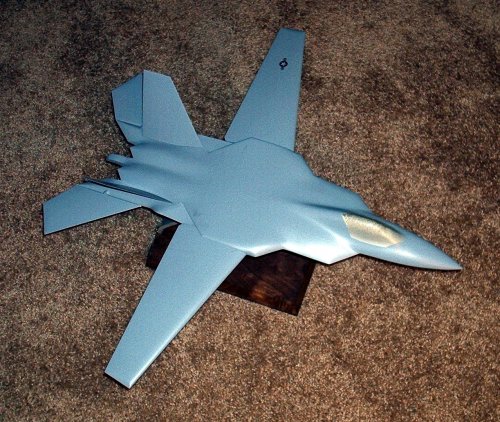 $T2eC16FHJIgFHR,VOjYJBR4h,hl(0Q~~60_57.JPG1.2 MB · Views: 690
$T2eC16FHJIgFHR,VOjYJBR4h,hl(0Q~~60_57.JPG1.2 MB · Views: 690 -
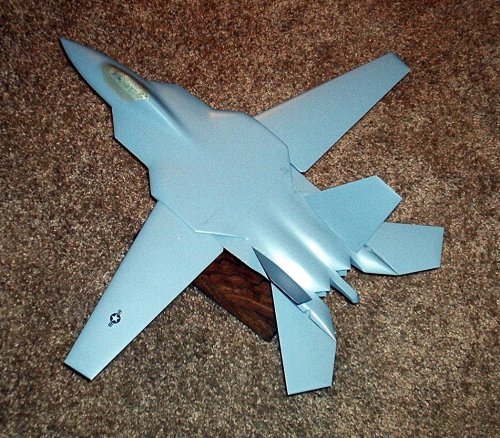 $T2eC16FHJGIFFo(5Me!rBR4h,Qy6eQ~~60_57.JPG959.5 KB · Views: 504
$T2eC16FHJGIFFo(5Me!rBR4h,Qy6eQ~~60_57.JPG959.5 KB · Views: 504 -
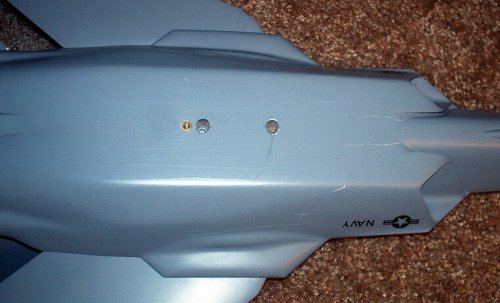 $T2eC16dHJF4FFk2D,6GFBR4h,081yg~~60_57.JPG520.9 KB · Views: 444
$T2eC16dHJF4FFk2D,6GFBR4h,081yg~~60_57.JPG520.9 KB · Views: 444 -
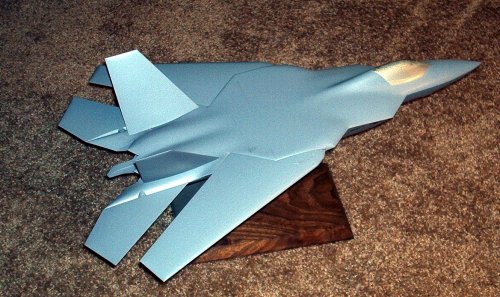 $(KGrHqZHJEMFG5gpPB!kBR4h,YELdw~~60_57.JPG1,002.4 KB · Views: 521
$(KGrHqZHJEMFG5gpPB!kBR4h,YELdw~~60_57.JPG1,002.4 KB · Views: 521 -
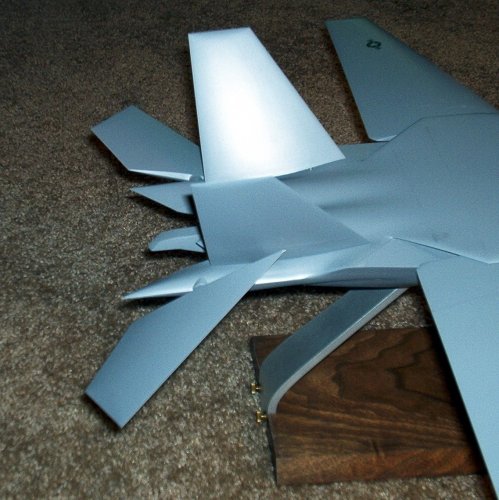 $(KGrHqZHJBwFG-15d19dBR4h,YnfSg~~60_57.JPG1,001.2 KB · Views: 487
$(KGrHqZHJBwFG-15d19dBR4h,YnfSg~~60_57.JPG1,001.2 KB · Views: 487 -
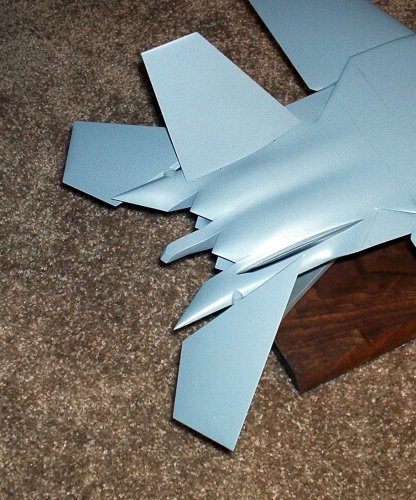 $(KGrHqVHJEIFHZvlYzf(BR4h,OET!w~~60_57.JPG811.4 KB · Views: 473
$(KGrHqVHJEIFHZvlYzf(BR4h,OET!w~~60_57.JPG811.4 KB · Views: 473 -
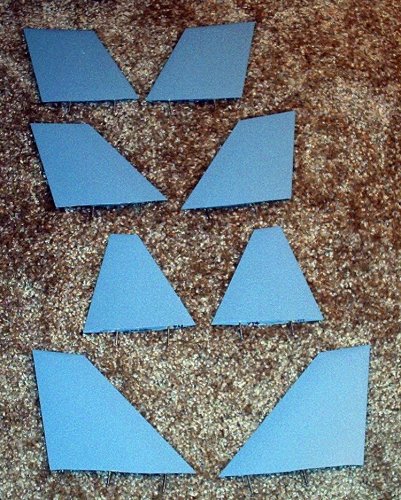 $(KGrHqFHJFIFG-bq4f8MBR4hZq8,r!~~60_57.JPG721.7 KB · Views: 757
$(KGrHqFHJFIFG-bq4f8MBR4hZq8,r!~~60_57.JPG721.7 KB · Views: 757 -
 $(KGrHqEOKo4FG6EkMdV9BR4h,leGCg~~60_57.JPG1 MB · Views: 836
$(KGrHqEOKo4FG6EkMdV9BR4h,leGCg~~60_57.JPG1 MB · Views: 836
- Joined
- 19 February 2007
- Messages
- 1,433
- Reaction score
- 2,668
Similar threads
-
-
FLIGHTS OF FANTASY: The Boeing/Lockheed A/FX
- Started by Sentinel Chicken
- Replies: 52
-
-
-
Advanced Tactical Support Aircraft (ATSA) US Navy
- Started by dauby09
- Replies: 22

